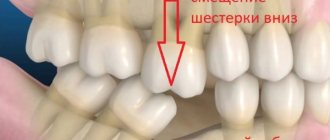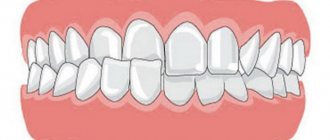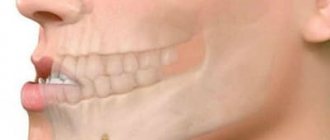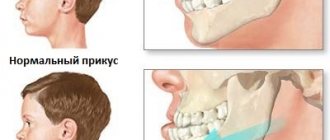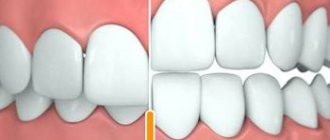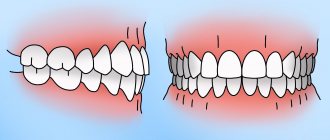Mesial occlusion or occlusion is one of the types of defects in which the closure of the anterior dentition is disrupted. Outwardly, this manifests itself in the dominance of the lower jaw over the upper. With such a violation, not only an aesthetic defect is observed. This leads to abrasion of tooth enamel and changes in facial expression. Typically, malocclusion develops due to genetic predisposition or exposure to causative factors during a certain period of development.
Mesial occlusion can be corrected professionally. A competent approach, modern equipment and doctors will be able to restore the aesthetic appearance of the face. Dental clinic PROPRIKUS provides treatment of mesial occlusion without the use of surgical intervention. To correct malocclusion, we use aligners, including Invisalign. They are considered the most effective and help correct even complex cases of pathological occlusion.
Mesial bite: what is it?
Mesial occlusion is a popular pathology of dental occlusion in children, which differs from other anomalies by significantly protruding lower teeth. There are:
- an overdeveloped lower jaw - true progeny;
- an underdeveloped upper jaw or constant advancement of the lower dentition forward - false progeny.
Regardless of the nature and external features of the manifestation of the pathology, it is necessary to treat it. Without correction of the bite, the patient can expect serious deformations of the oval of the face, problems with posture, digestion, and frequent headaches.
It is best to correct a mesial bite in childhood, while the skeleton is forming.
Diagnostics
Diagnosis begins with a visual examination by a doctor, and this should be an orthodontist. To determine the degree of mesial occlusion, the following studies and actions will be needed:
- assessment of facial anomalies, asymmetry;
- measuring the proportions of the jaw using measuring instruments;
- X-ray, teleradiography, orthopantomography;
- CT scan;
- on the articulators, clarify the inclination of the incisors to the temporal region;
- use bite pads;
- taking impressions of the jaw.
When palpating the TMJ (temporomandibular joint), the patient may feel pain and discomfort. To determine further treatment: how to correct mesial occlusion without surgery or whether it cannot be avoided, complete information about the current condition is necessary. And all innovative diagnostic methods are used.
Improper development of dentition, deformation.
Sometimes the relative position of the jaws prevents the teeth from closing normally, which forces the patient to force the lower jaw forward.
Rodikova Tatyana
In practice, there are often cases when the lower primary canines seem to block the upper jaw. And in order to close his mouth normally, the child moves his chin forward. A habit arises and an occlusion anomaly is formed - mesial occlusion.
Also, the reasons for the development of mesial occlusion include:
- abnormal development of the fetus during pregnancy;
- birth injuries;
- very short frenulum of the tongue;
- early eruption of lower primary teeth;
- incorrect head position during periods of child sleep;
- mouth breathing;
- Sucking fingers or objects is a constant bad habit of a child;
- bone diseases;
- poor posture;
- heredity;
- mistakes in choosing a pacifier when artificially feeding a baby.
Heredity is the main factor, since the pathology is based on disturbances in the development of jaw bone tissue and skeletal anomalies.
Prevention
To prevent progenia and prognathia, experts give the following recommendations:
- timely treat pathologies of the dental system;
- wean children from bad habits (sucking fingers, lips and others);
- control the position of the child’s body and head during sleep;
- monitor the child's posture.
Pregnant women need to be careful about their health. Proper nutrition with the required amount of vitamins and microelements is important. Also, you should try to protect yourself from infections and minimize stress. It is always easier to avoid violations than to deal with treatment later.
Timely detection of progenia and prognathia guarantees simpler and more effective therapy. Therefore, if you have symptoms of mesial or distal occlusion, you should not postpone a visit to the doctor.
Signs of mesial occlusion
Manifestations of pathology in most cases are obvious and pronounced. It is necessary to correct the bite if the child:
- the lower front teeth come forward, significantly overlapping the upper ones;
- the chin protrudes forward - it seems that the baby is constantly sad and looks gloomy;
- baby teeth began to change very early - the first ones to fall out were the ones in the lower jaw;
- lips are disproportionate in size - growth is often slightly open;
- the tip of the nose is directed downwards - the folds at the nostrils are clearly pronounced;
- the proportions of the face are disturbed - the middle third is sunken, and the lower third is enlarged and protrudes forward;
Adults should also pay attention to indirect signs. An incorrect bite is indicated by:
- Lisping speech - even a speech therapist cannot correct the unclearness of sounds; the situation worsens with age.
- Crunching and clicking when the lower jaw moves - when talking, yawning, chewing.
- Problems with the gastrointestinal tract - due to difficulties in chewing and poor digestion of food.
Parents often do not want to correct their child’s mesial bite, seeing the pathology only as an aesthetic problem. And some people don’t even notice this. A strong-willed chin is perceived by adults as dignity, and an “angry” facial expression is perceived as the seriousness of a child.
Plaksina Margarita
If a child shows signs of a progenetic malocclusion, I always insist on diagnosis and treatment. The older the child, the more difficult it is to correct. And besides, these are guaranteed health problems in the future - from complexes due to appearance to migraines and pain even when simply opening your mouth.
You know why you endure temporary inconvenience!
The devices we talked about today complicate the life of a person wearing braces, but if you follow the doctor’s recommendations, you don’t need to wear additional devices for very long.
In conclusion of the article, we would like to draw the attention of young parents to the importance of preventing defects of the dental system in children and the timely initiation of orthodontic treatment.
By following the recommendations of orthodontists, you can avoid the use of corrective equipment in adulthood. You will find out what these recommendations are by reading the article A beautiful smile of a child is the care of loving parents.
Orthodontists at NORD DENTAL clinics are ready to work hard and make your smile beautiful!
Sign up for a consultation and come >>
How to correct a mesial bite
Malocclusion needs to be corrected as early as possible. Separate therapy is provided for each age. There are corrections for very young children, preschoolers, schoolchildren and teenagers, adults.
Correcting a mesial bite at 2 years of age is primarily a fight against the child’s bad habits, surgical correction of a short frenulum of the tongue.
If signs of an underdeveloped upper jaw are detected early, massage of the alveolar processes is recommended. Stimulation of the alveoli maintains tone and stops pathological development.
Myogymnastics also helps a lot. A set of simple exercises is aimed at correcting defects and preventing deterioration in the quality of occlusion in a child.
Myogymnastics for correcting mesial occlusion
Exercises are performed daily under the supervision of an orthodontist or a parent. The child is asked:
- Press the tip of your tongue on the upper front teeth from the inside until the muscles become tired.
- Bite your lower lip with your upper teeth. Hold for a while, release. Repeat several times.
- Sitting with a straight back, throw your head back - open and then close your mouth, and when closing, reach the back edge of the hard palate with your tongue, massage it.
- Open your mouth and when closing, put your lower jaw in the correct position. Hold for as long as possible until the first muscle pain occurs.
Myogymnastics is prescribed only by a doctor if this type of correction is indicated. Self-treatment without prescription and selection of exercises can only worsen the situation.
Classification
In dentistry, the classification of mesial occlusion is quite expanded and expanded over the last century. Even back in 2004, Persin L.S. proposed his own system of 9 classes, based on the experience of previous years.
- lower macrognathia (hyperdevelopment of the jaw);
- lower prognathia (the jaw protrudes significantly forward);
- upper micrognathia (underdevelopment of the jaw);
- upper retrognathia (displacement of the jaw deeper into the skull);
- superior micrognathia and inferior macrognathia;
- superior retrognathia and inferior prognathia;
- upper micrognathia and lower prognathia;
- superior retrognathia and inferior macrognathia;
- habitual protrusion of the lower jaw forward.
Mesial occlusion is distinguished by prognathia, which can be:
- true;
- false.
True
- pronounced facial asymmetry, severe speech impediment. It appears at an early age. This is macrognathia of the lower jaw and/or its prognathia. Correction of mesial occlusion must begin at the age of 5-7 years, for now in the form of therapy.
False
- the lower jaw is of normal size, and the upper jaw is underdeveloped and/or recessed into the skull. This type of jaw progeny cannot always be noticed at first glance. But x-rays and computed tomography give a clear understanding of the pathology.
Classification of the degree of curvature:
- First degree
- visually imperceptible anomalies, the size of the gap between the teeth is up to 2 mm, the lower incisors protrude slightly. - Second degree
- a “strong-willed chin” appears, the gap increases to 10 mm, the fangs of the lower jaw constantly touch the mucous membrane of the upper lip. - Third degree
- the lower jaw moves forward and it is clearly noticeable that it is larger than the upper jaw, the gap is more than 10 mm between the teeth, the incisors do not touch each other. Other abnormalities may be present—dental crowding is one of them.
The third degree of curvature is dangerous because almost always such mesial displacement of the teeth turns into an open bite. And it may not be possible to correct a mesial bite with braces.
Another type of displacement separation by shape:
- dentoalveolar
- the lower jaw can fall into place on its own, move back with normal closure of the lateral teeth; - gnathic
- in this case, spontaneous shift is impossible; - mixed
.
We have not described all types; there are many classifications in the medical literature, as well as clinical cases.
Correction without surgery
If there are contraindications to surgery, older people undergo complex orthodontic treatment (installation of braces or mouth guards). The orthodontic system is also worn after surgery (at the end of the rehabilitation period). This method helps ensure perfect contact between opposing teeth. To correct the shape of teeth, veneers, crowns, and lumineers are used.
Sometimes, during the formation of the dentition, they resort to the removal of teeth - fours or eights. The absence of some dental units helps to align the dentition and somewhat reduce the dentoalveolar part of the jaw.
Promotions valid today:
Health as a Gift
Share the link:
- Click here to share content on Facebook. (Opens in a new window)
- Click to share on WhatsApp (Opens in new window)
pediatric dentistry, orthodontics, topic articles: Herbst apparatus, distal bite, bite correction, face bow, face mask, mesial bite, microimplants, palatal clasp, palatal expander
When progeny is the norm
When a patient is told that he has a progenic bite, this does not always mean that treatment is necessary. This form may be a variant of the norm, and not a pathological manifestation.
Signs of normal progeny are the following:
- both jaw joints are subject to uniform load during chewing;
- no malfunctions are detected in the operation of the dentofacial apparatus, and the function is performed fully;
- the gums of both jaws are completely healthy, there is no inflammation or threat of the onset of an inflammatory process, there is no bleeding;
- The lower teeth are moved forward slightly without any disruption of function.
Normal progeny does not lead to the appearance of dental diseases or disruptions in the functioning of other body systems, and therefore does not require treatment.
The only reason why a patient might be interested in correcting a normal progenic shape is for aesthetic reasons. In men, a normal progenic bite causes a strong-willed facial expression, which in most cases does not affect their attractiveness, and sometimes even enhances it. This facial expression suits women very rarely, so they can initiate correction.
Anatomy of the human lower and upper jaw
The dento-maxillary part of the facial skeleton forms a person’s face, his individual portrait. To maintain vital functions, the jaws perform the following functions:
- chewing food and swallowing,
- sound speech generation,
- participation in breathing,
- creation of cavities for the functioning of sensory organs.
The upper jaw has many functions. If it is overdeveloped and protrudes forward, symptoms of prognathia of the upper jaw occur. Consider the following anatomical features:
- Connected to all parts of the skull, it is part of the walls of the orbits, nasal cavity, infratemporal region and pterygoid palatine fossa.
- It contains a cavity up to 6 cm³ - the largest sinus among the formations of the skull.
- Consists of the body and palatine, zygomatic, alveolar, frontal processes.
- The body includes the anterior, nasal, orbital and infratemporal surfaces.
- The articulation with the bones of the skull is motionless.
- It has a concave shape, at the bottom there is an alveolar process, on which there are cells for the roots of the teeth, and between them there are partitions. Muscles for moving the corners of the mouth emanate from the cells of the upper canines, and through them go the arteries and infraorbital nerves.
- The border of the anterior surface is the nasal notch. On the infratemporal surface there are four openings of the alveoli, in which large molars originate.
- The upper jaw contains small plates that regulate access to the airways into the cavity within the body of the jaw. Near the bottom of the cavity are the apices of the roots of the premolar, first and second molars.
- There are many small grooves on the tubercle of the upper jaw. They provide passage to the teeth for nerve processes and capillaries.
Treatment in adults
In adults, it is more difficult to correct the size of the jaw bones using hardware methods. Orthodontic structures can straighten the dentition, but they cannot change the size and position of the jaw. Complex violations are eliminated surgically, after which ideal contacts between antagonist teeth are achieved using a braces system.
In mild cases, when the anomaly in the structure of the jaws is not clearly expressed and there are no problems with closing the lips and teeth, surgical intervention is not resorted to. In this case, the use of orthodontic systems helps. But to achieve a visible effect, you will have to wear the braces system for 3-5 years.
general information
In medical terminology, occlusion refers to the relationship of teeth. The dentist analyzes the state of the chewing muscles and the temporomandibular joint at the moment when the jaws are clenched.
Bite is the position of the teeth in relation to each other when the jaws are fully closed.
There are physiological and pathological or, respectively, correct and incorrect bites.
A physiological bite in humans ensures high-quality functioning of the dental system (chewing food), clear diction, free breathing and an attractive smile.
With a correct bite, the face is harmonious, the lower and upper jaws are formed proportionally, the load on all teeth is carried out evenly, the vertical axis of symmetry of the face crosses the junction between the front incisors. This allows a person to chew food thoroughly without injuring soft tissue or periodontium and without overloading the temporomandibular joint.

